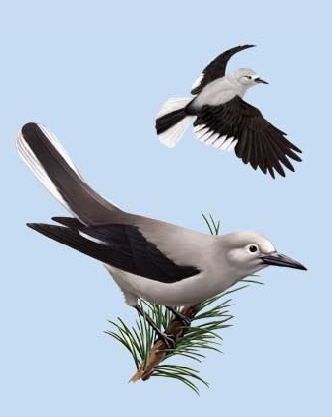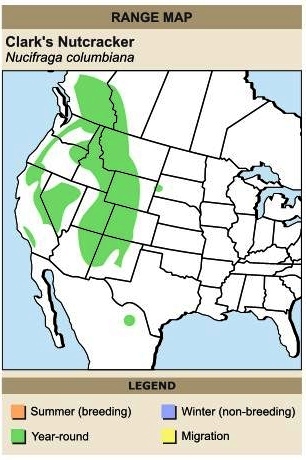
Medium,
noisy and inquisitive jay with pale gray head and body. Black bill is
long and stout. Wings are black with white patches and tail is black
with
white edges. Feeds on nuts, insects,
eggs and young of other birds, lizards, carrion and small mammals.
Steady deep wing beats.

CLARK’S
NUTCRACKER
Nucifraga columbiana
PASSERIFORMES
Crows and Jays (Corvidae)
Range
and Habitat
Resident in southern British Columbia and Alberta south California and
Colorado; prefers stands of junipers and ponderosa pines on high mountain
ranges near the tree line.
SOUND: "caw", "kra-a-a"
The Clark’s Nutcracker has a special pouch under its tongue in
which it carries pine seeds long distances to cache them. Depending
upon the species of pine seed, this pouch will hold from 28 and 90 seeds.
Unusual among members of the crow family, males of this species help
the females incubate the eggs.
In fact the males have brood pouches just like the females. Nestlings
are fed pine seeds from the parents’ caches.
This allows the adults to breed as early as January or February despite
the harsh winter weather in their range.
This bird was first observed in 1805 by William Clark (Lewis and Clark
expedition) and bears his name.
A group of nutcrackers has many collective nouns, including a "ballet",
"booby", "jar", and "suite" of nutcrackers.
The Common Black-Hawk is a bird of prey, and is related to eagles, hawks
and vultures. Breeding grounds of the species are located throughout
the Americas, including the southwestern United States, Central America,
Venezuela, Peru, Trinidad and the Lesser Antilles. The Common Black-Hawk
is a coastal bird and typically a resident all year long, though some
migratory populations exist. These populations fly south to northwestern
Mexico and Arizona in the winter months.

They prefer to breed
and nest in mangrove swamps with
adjacent dry, open woodlands. Their diet consists of crab,
eggs and small vertebrates.
|